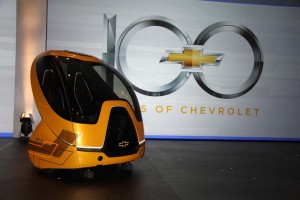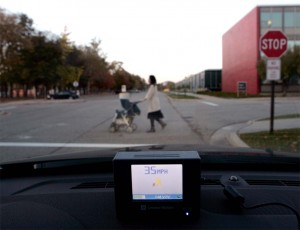The latest smartphones can do just about everything but cook breakfast – though they can help track down the recipe for a mean Eggs Benedict. Now, General Motors is looking at ways to link smartphones to alert your car to unseen pedestrians and other obstacles.
In effect, a network of smartphones – paired with fixed cameras and other roadside sensors – could create a wireless safety net, the maker suggests. Dubbed vehicle-to-vehicle or vehicle-to-infrastructure communications, such systems could help avert nearly 81 percent of all U.S. vehicle crashes, according to a study by the National Highway Traffic Safety Administration.
Such technology could be in place within a decade, adds the automaker – which recently showed off a vehicle that might be able to integrate the technology, the second-generation Chevrolet EN-V.
“These safety systems could provide a significant leap in automotive safety, but their effectiveness goes up dramatically as more people use them,” said Don Grimm, senior researcher for GM’s Perception and Vehicle Control Systems group. “By putting the technology into portable devices, we could make this potentially life-saving technology widely available and more affordable.”

The 2nd-generation Chevrolet EN-V could use advanced communications systems to watch out for obstacle - even drive autonomously.
GM says it is working on several alternative approaches. One would use a portable GPS-sized transponder. The other would make use of the increasingly popular smartphones that are rapidly becoming a ubiquitous automotive accessory. Eventually, the technology either could be built into a car or a vehicle like EN-V could use a Bluetooth link to an iPhone or similar device.
The technology would use Dedicated Short-Range Communications – which has a range of about a quarter mile – to communicate with other vehicles, traffic signals, warning beacons at work sites and even cellphones carried by pedestrians or bicyclists.
Were your car to hit an icy patch, for example, triggering the vehicle’s stability control, it might send an alert to other cars in the immediate vicinity warning of bad road conditions. A bike rider out after dark could alert oncoming traffic long before they become visible.
“The technology we’re testing right now is a viable solution for providing crucial safety information to drivers,” Grimm said. “Instead of just seeing what’s right in front of them, drivers will be able to know about the truck a quarter-mile ahead that’s stalled in their lane. Later this decade, smartphones, transponders and embedded systems could be working together to make our roadways safer.”
The EN-V, a 2-seat concept that looks like a high-tech rickshaw, could even use the technology to drive autonomously, according to GM officials. The problem is that while it would be relatively easy to integrate vehicle-to-vehicle and vehicle-to-infrastructure systems into a new car, truck or crossover, the challenge will be to make the technology available to a wider audience.
The average car is now in use for 10.2 years, according to research by R.L. Polk, and motorists replace only a small fraction of the roughly 250 million vehicles on U.S. roads each year. Using portable devices – whether a GPS-like transponder or a smartphone – could make such technology available to the masses much more quickly.

